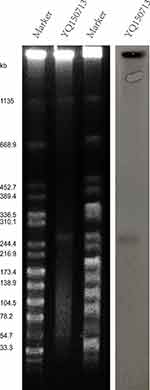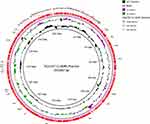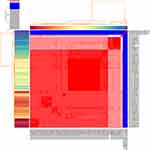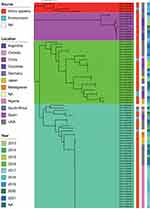Back to Journals » Infection and Drug Resistance » Volume 16
Detection of NDM-1 and OXA-10 Co-Producing Providencia rettgeri Clinical Isolate
Authors Li Y, Shao K, Cai R, Liu Y, Liu X, Ni F, Zheng H, Hu R, Sun T
Received 7 May 2023
Accepted for publication 11 July 2023
Published 15 August 2023 Volume 2023:16 Pages 5319—5328
DOI https://doi.org/10.2147/IDR.S418131
Checked for plagiarism Yes
Review by Single anonymous peer review
Peer reviewer comments 2
Editor who approved publication: Prof. Dr. Héctor Mora-Montes
Yaling Li,1,* Kaiyang Shao,1,* Ruyi Cai,1 Yi Liu,2 Xiaojing Liu,2,3 Feihua Ni,1 Huiyan Zheng,1 Ruying Hu,1 Ting Sun1
1Department of Health Management Center, the Second Affiliated Hospital, Zhejiang University School of Medicine, Hangzhou, Zhejiang, People’s Republic of China; 2Collaborative Innovation Center for Diagnosis and Treatment of Infectious Diseases, State Key Laboratory for Diagnosis and Treatment of Infectious Diseases, the First Affiliated Hospital, College of Medicine, Zhejiang University, Hangzhou, Zhejiang, People’s Republic of China; 3Shandong First Medical University and Shandong Academy of Medical Sciences, Jinan, Shandong, People’s Republic of China
*These authors contributed equally to this work
Correspondence: Ting Sun, Department of Health Management Center, the Second Affiliated Hospital, Zhejiang University School of Medicine, Hangzhou, 310009, Zhejiang, People’s Republic of China, Email [email protected]
Background: The coexistence of blaNDM-1 with other resistance determinants is rarely reported for Providencia rettgeri. Therefore, this study investigates the phenotypic and genetic characteristics of a multidrug-resistant P. rettgeri strain YQ150713.
Methods: P. rettgeri YQ150713 was identified as carrying blaNDM-1. S1-pulsed-field gel electrophoresis (S1-PFGE), Southern blotting, and conjugation experiments were used to determine plasmid characteristics. An antimicrobial susceptibility test was conducted. The complete genomic sequence of YQ150713 was obtained using Illumina NovaSeq 6000 and Oxford nanopore platforms. To further characterize the phylogenetic structure of P. rettgeri YQ150713, average nucleotide identity (ANI) and phylogenetic analyses were conducted.
Results: The S1-PFGE, Southern blot, and conjugation assays have confirmed that the isolate P. rettgeri YQ150713 contains the blaNDM-1 gene on a conjugative plasmid pYQ150713-NDM-1. Antimicrobial susceptibility testing has indicated that strain YQ150713 was resistant to various common antibiotics, except aztreonam and fosfomycin. Bioinformatics analysis has further shown that pYQ150713-NDM-1 was a novel plasmid with a size of 265,883 bp, and blaNDM-1 and blaOXA-10 were co-located on it. Phylogenetic analysis suggesting P. rettgeri has spread widely throughout the world.
Conclusion: In this study, blaNDM-1 and blaOXA-10 were co-localized on a novel plasmid pYQ150713-NDM-1 with a horizontal transfer function. To reduce the risk of the dissemination of such P. rettgeri isolates in clinical settings, more surveillance will be required in the future.
Keywords: antimicrobial resistance, blaNDM-1, blaOXA-10, Providencia rettgeri, carbapenemase-producing, average nucleotide identity, phylogenetic
Introduction
Providencia rettgeri is a Gram-negative opportunistic human pathogenic bacterium that belongs to the Proteae bacteria. It is a pathogen commonly found in the hospitals that mainly cause urinary tract infections, pneumonia, bacteremia, neonatal sepsis, eye infections, meningitis, endocarditis, and diarrhea.1–3 The pathogen Providencia rettgeri demonstrates inherent resistance to numerous antimicrobial agents, such as ampicillin, first-generation cephalosporins, polymyxins, and tigecycline, thereby posing significant challenges in the management of infections caused by this microorganism. Moreover, the escalating prevalence of multidrug-resistant (MDR) strains of P. rettgeri poses a global threat to public health.4 MDR bacterial infections were widely treated with carbapenems. However, a number of carbapenemase-producing P. rettgeri isolates have been found carrying carbapenem-resistant genes like blaNDM, blaVIM, and blaIMP-27.5–8 A neonate was reported to have suffered from a late-onset case of neonatal sepsis caused by MDR P. rettgeri that was resistant to ampicillin, polymyxins, and first-generation cephalosporins.9,10 In 2014, P. rettgeri was first reported to produce NDM-1 in China.11 However, the detection rate of NDM-1 in P. rettgeri isolates continues to increase around the world. As far as we know, P. rettgeri carrying blaNDM-1 has been reported in Israel, Brazil, Argentina, and Colombia.6,12–15
The existence of blaNDM-1 within a bacterial isolate poses a significant challenge for clinical therapeutics. Nevertheless, the challenge becomes even more formidable when it coexists with other resistance determinants, as this leads to a more pronounced restriction of available treatment options. There are few reports about P. rettgeri coexisting blaNDM-1 with other resistance determinants. A study by Piza-Buitrago et al6 reported the coexistence of β- lactamase genes including blaNDM-1, blaVIM-2, and blaCTX-M-15, blaOXA-10, blaCMY-2 and blaTEM-1 in P. rettgeri isolates from two patients in Colombia. The objective of this study was to assess the co-harboring of blaNDM-1 and blaOXA-10 in P. rettgeri isolated from a patient with pulmonary infection in China. Furthermore, the significance of continuous surveillance of β-lactamase-carrying P. rettgeri strains in clinical settings was underscored.
Materials and Methods
Strain Collection and Species Identification
Strain YQ150713 was obtained from a 79-year-old patient admitted to a tertiary hospital in Zhejiang province, China with pulmonary infection. The collected sputum sample was plated on Columbia Blood agar plate (Autobio, China) and identification of isolates by matrix-assisted laser desorption ionization time-of-flight mass spectrometry (MALDI-TOF-MS) (Bruker, Bremen, Germany). As described previously, blaNDM-1 gene were detected by PCR and Sanger sequencing.16
S1-PFGE, Southern Blot Hybridization and Conjugation Experiments
The size and number of P. rettgeri YQ150713 plasmids were identified by S1-pulsed-field gel electrophoresis (S1-PFGE). The location of blaNDM-1 was detected by Southern blotting and hybridization with DIG-labeled blaNDM-specific probe. To verify plasmid transferability, a conjugation experiment was conducted using rifampicin-resistant E. coli 600 and J53 as recipients.17 The transconjugants were selected on Mueller-Hinton agar (OXOID, Hampshire, UK) medium containing both 200 mg/L rifampin/sodium azide and 2 mg/L meropenem. Finally, a combination of MALDI-TOF-MS and PCR was conducted to ensure successful transfer of the plasmid to the recipient strain.
Antibiotic Sensitivity Test
Broth microdilutions were used to determine the susceptibility of P. rettgeri YQ150713 and transconjugants to antibiotics. The tested antibiotics were β-lactams (amoxicillin/clavulanic acid, aztreonam, ceftazidime, ceftriaxone, cefepime, cefotaxime, imipenem, meropenem and piperacillin/tazobactam), fluoroquinolones (levofloxacin, ciprofloxacin), trimethoprim/sulfamethoxazole, aminoglycosides (amikacin, gentamicin), fosfomycin. The interpretation of results was based on Clinical and Laboratory Standards Institute (CLSI) guidelines (https://clsi.org). The quality control strains were E. coli ATCC 25922 and P. aeruginosa ATCC 27853.
Whole Genome Sequencing (WGS) and Bioinformatics Analysis
Genomic DNA extraction was performed using a commercial kit (QIAGEN, Gentra Puregene Yeast/Bact.Kit, Germany) following the manufacturer’s instructions. Short and long reading data were then obtained from DNA sequencing on the Illumina NovaSeq 6000 (Illumina, San Diego, California, United States) and Oxford nanopore platforms (Oxford nanopore technologies, Oxford, United Kingdom). The Unicycler v0.4.7 software was utilized for hybrid assembly in order to obtain the complete genome sequence of YQ150713.18 Subsequently, Prokka was employed to annotate the genome. ResFinder and PlasmidFinder databases were used to identify the antimicrobial resistance genes (ARGs) and replicon type of plasmids.19 Finally, we employed the BLAST Ring Image Generator (BRIG) to generate a circular representation of the plasmid, while Easyfig was utilized to produce linear comparison figures of the genetic environment encompassing the blaNDM-1 and blaOXA-10 genes.20,21
Phylogenetic Analysis
To further characterize the phylogenetic structure of NDM-1-producing P. rettgeri, 218 genomes of P. rettgeri isolates were downloaded from the National Center for Biotechnology Information (NCBI) Genome database as of March, 2022 to perform coregenome analysis. Strains’ average nucleotide identity (ANI) was analyzed by Pyani to eliminate confounding strains.22,23 Species were determined using Pyani with default settings if the genome had an ANI value greater than 95% (https://github.com/widdowquinn/pyani). Roary was then used to perform phylogenetic analyses on 80 P. rettgeri isolates and 4 Providencia sp. (NCTC10286- Providencia alcalifaciens, NCTC6933-Providencia rustigianii, NCTC12003-Providencia heimbachae, ATCC33672-Providencia stuartii).24 Finally, MEGA X was used to generate a maximum likelihood phylogenetic tree and an Interactive Tree of Life (https://itol.embl.de/) was used to modify the visualizations of the phylogenetic tree.
Results
Antimicrobial Susceptibility Profiles
In this study, a total of 15 antibiotics were tested (Table 1). The results revealed that isolate YQ150713 demonstrated resistance to various antibiotics, including amoxicillin/clavulanic acid (MIC>128mg/L), piperacillin/tazobactam (MIC=64mg/L), ceftazidime (MIC>128mg/L), ceftriaxone (MIC=128mg/L), cefepime (MIC=16mg/L), cefotaxime (MIC=128mg/L), ciprofloxacin (MIC=64mg/L), levofloxacin (MIC=32mg/L), imipenem (MIC=16mg/L), meropenem (MIC=4mg/L), trimethoprim/sulfamethoxazole (MIC>152mg/L), amikacin (MIC>128mg/L), gentamicin (MIC>128mg/L). However, it was sensitive to aztreonam and fosfomycin. Furthermore, the transconjugants YQ150713-NDM-EC600 and YQ150723-NDM-J53 also demonstrated resistance to imipenem and meropenem. YQ150713-NDM-EC600 was sensitive to ciprofloxacin and levofloxacin, while YQ150723-NDM-J53 was sensitive to cefepime and levofloxacin.
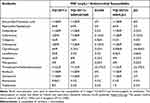 |
Table 1 Antimicrobial Drug Susceptibility Profiles |
Characterization of Plasmid pYQ150713-NDM-1
The YQ150713 isolate was found to possess a plasmid of approximately 260kb in size, carrying the blaNDM-1 gene, as revealed by the results obtained from S1-PFGE, Southern blotting, and hybridization techniques. This particular plasmid was assigned the designation pYQ150713-NDM-1. (Figure 1). The presence of blaNDM-1 in transconjugants was confirmed by PCR and Sanger sequencing. WGS revealed that blaNDM-1 and blaOXA-10 were co-localized on the plasmid pYQ150713-NDM-1 with a size of 265, 883 bp. Interestingly, a comparison of the full plasmid BLAST showed that pYQ150713-NDM-1 had very low similarity to other plasmids (Figure 2), indicating that it is a novel blaNDM-carrying plasmid. The blaNDM-1 and blaOXA-10 genes were found to be co-located on a Tn3 transposon element in pYQ150713-NDM-1 with the following linear structure (Figure 3): TnAs2-hin-xerC-dhfrI-ORF-blaOXA-10-ant1-emrE-ORF-ORF-trpF-ble-blaNDM-1-cat-ORF-emrE-ORF-ORF-ISEc35. NCBI BLAST analysis revealed that the Tn3 transposon element environment of pYQ150713-NDM-1 was genetic similarity with Proteus mirabilis plasmid pDY.F1.2 (CP046050), Proteus mirabilis plasmid pSNYG35 (CP047590), and Escherichia coli plasmid pEC8-NDM-1(CP060954).
Strain Identification and Phylogenetic Analysis
After ANIb analysis based on BLAST, strain YQ150713 was finally identified as P. rettgeri (Figure S1). According to the result of ANIb analysis, 80 strains downloaded from NCBI assemble database and were used together with YQ150713 for phylogenetic analysis (Figure 4, Table S1). All specimens were obtained from a clinical setting. The results illustrated that the 81 strains aggregated into three clusters, namely cluster I, cluster II, cluster IIIa, cluster IIIb(Figure 5). YQ150713 was belonged to cluster II, and it was close to GCA 006351125.1, GCA 016512695.1, GCA 020564615.1, GCA 021869825.1, and GCA 020683065.1. Among them, GCA 006351125.1 was collected from patient’s urine in Sichuan province, China, GCA 016512695.1 was collected from a COVID-19 patient’s blood in the USA. GCA 020564615.1, GCA 021869825.1, and GCA 020683065.1 were from Bogota, Colombia, with two of them were collected from urine on April, 2019, suggesting P. rettgeri spread widely in the world.
Discussion
This study presents a description of a clinical strain of P. rettgeri in China, which carries a novel blaNDM-1 plasmid named pYQ150713-NDM-1. The plasmid co-localized β-lactamase genes blaNDM-1 and blaOXA-10.
Besides being found in environmental settings, P. rettgeri species have also been reported as opportunistic human pathogens in clinic. The first isolation of blaNDM-1 producing P. rettgeri was reported in Israel in 2013.12 Since then, blaNDM-1- producing P. rettgeri has been reported worldwide, including Asia (Israel, India, Korea, Nepal, China, Pakistan),11,12,25–28 South America (Brazil, Colombia, Argentina, Ecuador),13,14,29,30 North America (Mexico),31 South Africa (Nigeria)32 and South East Europe (Bulgaria).33 Most blaNDM genes are present in conjugative plasmids while the characteristics of a host plasmid can differ greatly in terms of size, incompatibility group, gene content, and organization. A previous study reported that blaNDM is carried in a great variety of plasmids belonging to diverse Inc groups (FII, FIB, A/C2, HI1A, HI1B, L/M, N, N2, X3, R, T as well as unclassified plasmids).34 In this study, the PlasmidFinder tool was employed to determine the compatibility group of the plasmid. However, the plasmid under investigation could not be classified into any known incompatibility group, suggesting that the plasmid type of pYQ150713-NDM-1 is novel. Interestingly, there was another β -lactamase gene blaOXA-10 located on pYQ150713-NDM-1 plasmid.
The antimicrobial resistance tests indicated that strain YQ150713 exhibited resistance to a wide spectrum of antimicrobials, which was found to be in concordance with the presence of acquired antibiotic resistance genes in its genomic composition. This implies that the presence of genetically resistant genes in pYQ150713-NDM-1 could significantly contribute to the multidrug resistance observed in isolate YQ150713. The results of conjugation experiments showed that blaNDM-1 was successfully transmitted from P. rettgeri YQ150713 to E. coli 600 and E. coli J53. The pYQ150713-NDM-1 plasmid has horizontal metastatic ability and is capable of expressing drug resistance. These results indicated that the transferability of the plasmid increases the risk of drug-resistant bacteria and poses a great challenge to clinical treatment.
Strain YQ150713 demonstrated resistance to the carbapenems imipenem and meropenem, likely attributable to the presence of blaNDM-1 and blaOXA-10 genes. While Shen et al15 and Piza-Buitrago et al6 reported the co-existence of blaNDM-1 and blaOXA-10 in P. rettgeri, their study only clarified the transmission of blaNDM-1 through plasmids, but did not explain whether blaOXA-10 co-existed with blaNDM-1 on the same plasmid. Zhang et al35 provided a comprehensive analysis of the genetic context of a circular plasmid measuring 273.2 Kb, which harbored blaNDM-1, blaOXA-10, and blaPER-4 genes in P. rettgeri. Horizontal transmission of interbacterial resistance can occur by conjugating plasmids and integrating conjugative elements. Our study corroborates these findings. We further describe the characterization of pYQ150713-NDM-1 plasmid, where the blaNDM-1 and blaOXA-10 genes were found to be co-located on a Tn3 transposon element in pYQ150713-NDM-1 with the following linear structure: TnAs2-hin-xerC-dhfrI-ORF-blaOXA-10-ant1-emrE-ORF-ORF-trpF-ble-blaNDM-1-cat-ORF-emrE-ORF-ORF-ISEc35. Furthermore, the presence of mobile elements TnAs2 and ISEc35 in close proximity to pYQ150713-NDM-1 enhances the potential for dissemination of drug resistance genes. Consequently, it is imperative to prioritize routine testing and administer suitable treatment to patients. NCBI BLAST analysis revealed that the complete sequence of pYQ150713-NDM-1 had genetic similarity with Proteus mirabilis plasmid pDY.F1.2 (CP046050), Proteus mirabilis plasmid pSNYG35 (CP047590), and Escherichia coli plasmid pEC8-NDM-1(CP060954). It is noteworthy that all four plasmids were identified from isolates in China. Escherichia coli plasmid pEC8-NDM-1 was identified from a clinical urine sample. However, Proteus mirabilis plasmid pDY.F1.2 were identified from Swine and Proteus mirabilis plasmid pSNYG35 were from broiler chicken. These data indicate that blaNDM-1-carrying plasmid identified in this study might disseminate from food-producing animals to humans, and the proliferation of plasmids represents a potential public health risk. In conclusion, to curb further spread of plasmids bearing blaNDM-1 and blaOXA-10, it is imperative that an effective prevention strategy should be adopted.
In order to examine the genetic relatedness of P. rettgeri YQ150713 with previously documented strains, a core genome phylogeny analysis was conducted. As showed in Figure 5 and Table S1, P. rettgeri strains were mainly isolated from clinical samples, with few strains from environments. Further, P. rettgeri strains were mainly found in USA, and Nigeria. P. rettgeri YQ150713 had a close relationship with GCA 006351125.1 from China, GCA 016512695.1 from USA, GCA 020564615.1, GCA 021869825.1 and GCA 020683065.1 from Colombia. All of these strains were obtained from clinical samples, suggesting a widespread presence of P. rettgeri in clinical settings. In order to mitigate the potential dissemination of these P. rettgeri isolates within clinical environments, enhanced surveillance is imperative in forthcoming studies.
Nucleotide Sequence Accession Numbers
A complete sequence of the nucleotides described in this paper has been deposited in GenBank under accession number SAMN27400906.
Conclusion
In summary, we found blaNDM-1 and blaOXA-10 were co-localized on a novel plasmid pYQ150713-NDM-1 which has a horizontal transfer function and a certain ability to spread. To reduce the risk of the dissemination of such P. rettgeri isolates in clinical settings, more surveillance is needed in the future.
Ethical Approval
Ethics Committee of First Affiliated Hospital of Zhejiang University has approved the protocol (no. 2021–631). The patient provided written informed consent.
Disclosure
The authors of this article have no conflict of interest.
References
1. Marquez-Ortiz RA, Haggerty L, Olarte N, et al. Genomic Epidemiology of NDM-1-Encoding Plasmids in Latin American Clinical Isolates Reveals Insights into the Evolution of Multidrug Resistance. Genome Biol Evol. 2017;9(6):1725–1741.
2. Choi HK, Kim YK, Kim HY, Park JE, Uh Y. Clinical and microbiological features of Providencia bacteremia: experience at a tertiary care hospital. Korean J Intern Med. 2015;30(2):219–225.
3. Abdallah M, Balshi A. First literature review of carbapenem-resistant Providencia. New Microbes New Infect. 2018;25:16–23.
4. Mbelle NM, Osei SJ, Amoako DG, et al. Genomic analysis of a multidrug-resistant clinical Providencia rettgeri (PR002) strain with the novel integron ln1483 and an A/C plasmid replicon. Ann N Y Acad Sci. 2020;1462(1):92–103.
5. Gao H, Liu Y, Wang R, Wang Q, Jin L, Wang H. The transferability and evolution of NDM-1 and KPC-2 co-producing Klebsiella pneumoniae from clinical settings. Ebiomedicine. 2020;51:102599.
6. Piza-Buitrago A, Rincón V, Donato J, et al. Genome-based characterization of two Colombian clinical Providencia rettgeri isolates co-harboring NDM-1, VIM-2, and other β-lactamases. Bmc Microbiol. 2020;20(1):345.
7. Potter RF, Wallace MA, McMullen AR, et al. bla(IMP-27) on transferable plasmids in Proteus mirabilis and Providencia rettgeri. Clin Microbiol Infect. 2018;24(9):1015–1019.
8. Otlu B, Yakupoğulları Y, Gürsoy NC, et al. Co-production of OXA-48 and NDM-1 Carbapenemases in Providencia rettgeri: the first report. Mikrobiyol Bul. 2018;52(3):300–307.
9. Sharma D, Sharma P, Soni P. First case report of Providencia Rettgeri neonatal sepsis. BMC Res Notes. 2017;10(1):536.
10. Magiorakos AP, Srinivasan A, Carey RB, et al. Multidrug-resistant, extensively drug-resistant and pandrug-resistant bacteria: an international expert proposal for interim standard definitions for acquired resistance. Clin Microbiol Infect. 2012;18(3):268–281.
11. Zhou G, Guo S, Luo Y, et al. NDM-1-producing strains, family Enterobacteriaceae, in hospital, Beijing, China. Emerg Infect Dis. 2014;20(2):340–342.
12. Gefen-Halevi S, Hindiyeh MY, Ben-David D, et al. Isolation of genetically unrelated bla(NDM-1)-positive Providencia rettgeri strains in Israel. J Clin Microbiol. 2013;51(5):1642–1643.
13. Carvalho-Assef AP, Pereira PS, Albano RM, et al. Isolation of NDM-producing Providencia rettgeri in Brazil. J Antimicrob Chemother. 2013;68(12):2956–2957.
14. Pasteran F, Meo A, Gomez S, et al. Emergence of genetically related NDM-1-producing Providencia rettgeri strains in Argentina. J Glob Antimicrob Resist. 2014;2(4):344–345.
15. Shen S, Huang X, Shi Q, et al. Occurrence of NDM-1, VIM-1, and OXA-10 Co-Producing Providencia rettgeri Clinical Isolate in China. Front Cell Infect Microbiol. 2021;11:789646.
16. Zheng B, Huang C, Xu H, et al. Occurrence and Genomic Characterization of ESBL-Producing, MCR-1-Harboring Escherichia coli in Farming Soil. Front Microbiol. 2017;8:2510.
17. Liu R, Xu H, Guo X, et al. Genomic Characterization of Two Escherichia fergusonii Isolates Harboring mcr-1 Gene From Farm Environment. Front Cell Infect Microbiol. 2022;12:774494.
18. Wick RR, Judd LM, Gorrie CL, Holt KE. Unicycler: resolving bacterial genome assemblies from short and long sequencing reads. Plos Comput Biol. 2017;13(6):e1005595.
19. Anjum MF, Zankari E, Hasman H. Molecular Methods for Detection of Antimicrobial Resistance. Microbiol Spectr. 2017;5(6):564.
20. Sullivan MJ, Petty NK, Beatson SA. Easyfig: a genome comparison visualizer. Bioinformatics. 2011;27(7):1009–1010.
21. Alikhan NF, Petty NK, Ben ZN, Beatson SA. BLAST Ring Image Generator (BRIG): simple prokaryote genome comparisons. Bmc Genomics. 2011;12:402.
22. Konstantinidis KT, Tiedje JM. Genomic insights that advance the species definition for prokaryotes. Proc Natl Acad Sci U S A. 2005;102(7):2567–2572.
23. Wu H, Wang D, Gao F. Toward a high-quality pan-genome landscape of Bacillus subtilis by removal of confounding strains. Brief Bioinform. 2021;22(2):1951–1971.
24. Page AJ, Cummins CA, Hunt M, et al. Roary: rapid large-scale prokaryote pan genome analysis. Bioinformatics. 2015;31(22):3691–3693.
25. Tada T, Miyoshi-Akiyama T, Dahal RK, et al. NDM-1 Metallo-β-Lactamase and ArmA 16S rRNA methylase producing Providencia rettgeri clinical isolates in Nepal. Bmc Infect Dis. 2014;14:56
26. Lascols C, Hackel M, Marshall SH, et al. Increasing prevalence and dissemination of NDM-1 metallo-beta-lactamase in India: data from the SMART study (2009). J Antimicrob Chemother. 2011;66(9):1992–1997.
27. Shin S, Jeong SH, Lee H, Hong JS, Park MJ, Song W. Emergence of multidrug-resistant Providencia rettgeri isolates co-producing NDM-1 carbapenemase and PER-1 extended-spectrum beta-lactamase causing a first outbreak in Korea. Ann Clin Microbiol Antimicrob. 2018;17(1):20.
28. Perry JD, Naqvi SH, Mirza IA, et al. Prevalence of faecal carriage of Enterobacteriaceae with NDM-1 carbapenemase at military hospitals in Pakistan, and evaluation of two chromogenic media. J Antimicrob Chemother. 2011;66(10):2288–2294.
29. Zurita J, Parra H, Gestal MC, McDermott J, Barba P. First case of NDM-1-producing Providencia rettgeri in Ecuador. J Glob Antimicrob Resist. 2015;3(4):302–303.
30. Saavedra-Rojas SY, Duarte-Valderrama C, González-de-Arias MN, Ovalle-Guerro MV. Emergence of Providencia rettgeri NDM-1 in two departments of Colombia, 2012-2013. Enferm Infecc Microbiol Clin. 2017;35(6):354–358.
31. Barrios H, Garza-Ramos U, Reyna-Flores F, et al. Isolation of carbapenem-resistant NDM-1-positive Providencia rettgeri in Mexico. J Antimicrob Chemother. 2013;68(8):1934–1936.
32. Tshisevhe VS, Lekalakala MR, Tshuma N, Janse VRS, Mbelle N. Outbreak of carbapenem-resistant Providencia rettgeri in a tertiary hospital. S Afr Med J. 2016;107(1):31–33.
33. Pfeifer Y, Trifonova A, Pietsch M, et al. Clonal Transmission of Gram-Negative Bacteria with Carbapenemases NDM-1, VIM-1, and OXA-23/72 in a Bulgarian Hospital. Microb Drug Resist. 2017;23(3):301–307.
34. An J, Guo L, Zhou L, et al. NDM-producing Enterobacteriaceae in a Chinese hospital, 2014-2015: identification of NDM-producing Citrobacterwerkmanii and acquisition of blaNDM-1-carrying plasmid in vivo in a clinical Escherichia coli isolate. J Med Microbiol. 2016;65(11):1253–1259.
35. Zhang M, Yu Y, Wang Q, et al. Conjugation of plasmid harboring bla (NDM-1) in a clinical Providencia rettgeri strain through the formation of a fusion plasmid. Front Microbiol. 2022;13:1071385.
 © 2023 The Author(s). This work is published and licensed by Dove Medical Press Limited. The full terms of this license are available at https://www.dovepress.com/terms.php and incorporate the Creative Commons Attribution - Non Commercial (unported, v3.0) License.
By accessing the work you hereby accept the Terms. Non-commercial uses of the work are permitted without any further permission from Dove Medical Press Limited, provided the work is properly attributed. For permission for commercial use of this work, please see paragraphs 4.2 and 5 of our Terms.
© 2023 The Author(s). This work is published and licensed by Dove Medical Press Limited. The full terms of this license are available at https://www.dovepress.com/terms.php and incorporate the Creative Commons Attribution - Non Commercial (unported, v3.0) License.
By accessing the work you hereby accept the Terms. Non-commercial uses of the work are permitted without any further permission from Dove Medical Press Limited, provided the work is properly attributed. For permission for commercial use of this work, please see paragraphs 4.2 and 5 of our Terms.

